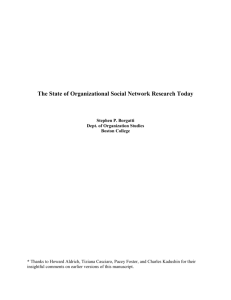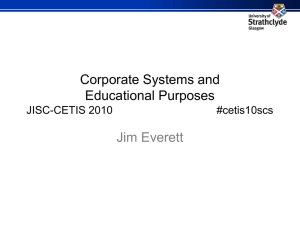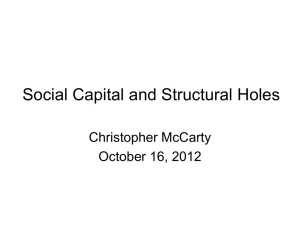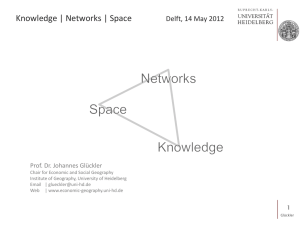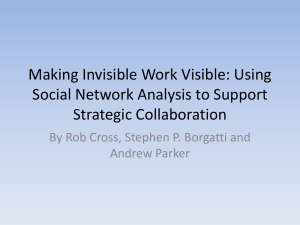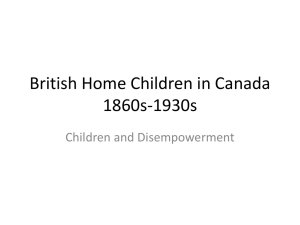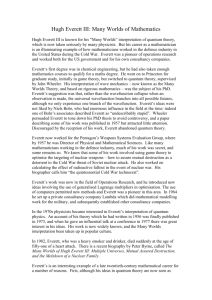Stephen Peter Borgatti - Analytic Technologies
advertisement
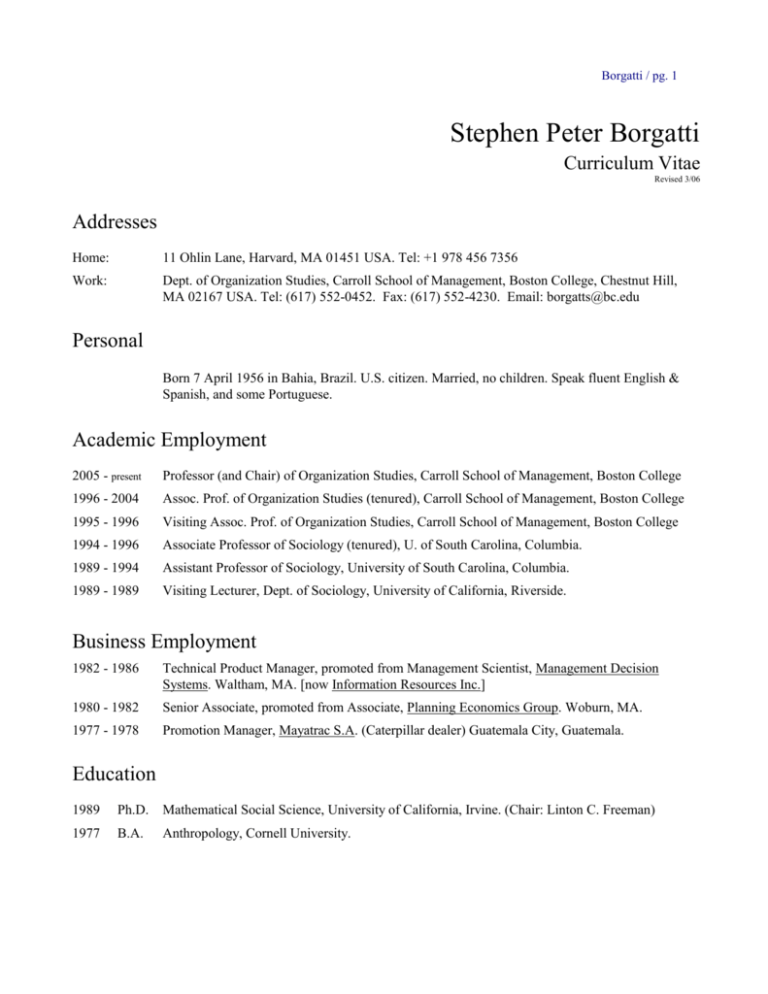
Borgatti / pg. 1 Stephen Peter Borgatti Curriculum Vitae Revised 3/06 Addresses Home: 11 Ohlin Lane, Harvard, MA 01451 USA. Tel: +1 978 456 7356 Work: Dept. of Organization Studies, Carroll School of Management, Boston College, Chestnut Hill, MA 02167 USA. Tel: (617) 552-0452. Fax: (617) 552-4230. Email: borgatts@bc.edu Personal Born 7 April 1956 in Bahia, Brazil. U.S. citizen. Married, no children. Speak fluent English & Spanish, and some Portuguese. Academic Employment 2005 - present Professor (and Chair) of Organization Studies, Carroll School of Management, Boston College 1996 - 2004 Assoc. Prof. of Organization Studies (tenured), Carroll School of Management, Boston College 1995 - 1996 Visiting Assoc. Prof. of Organization Studies, Carroll School of Management, Boston College 1994 - 1996 Associate Professor of Sociology (tenured), U. of South Carolina, Columbia. 1989 - 1994 Assistant Professor of Sociology, University of South Carolina, Columbia. 1989 - 1989 Visiting Lecturer, Dept. of Sociology, University of California, Riverside. Business Employment 1982 - 1986 Technical Product Manager, promoted from Management Scientist, Management Decision Systems. Waltham, MA. [now Information Resources Inc.] 1980 - 1982 Senior Associate, promoted from Associate, Planning Economics Group. Woburn, MA. 1977 - 1978 Promotion Manager, Mayatrac S.A. (Caterpillar dealer) Guatemala City, Guatemala. Education 1989 Ph.D. Mathematical Social Science, University of California, Irvine. (Chair: Linton C. Freeman) 1977 B.A. Anthropology, Cornell University. Borgatti / pg. 2 Grants 2005 Diversity and Social Capital: The Effect of Social Identity Salience and Network Structure on the Development of Negative Relationships. $2,000. Research Expense Grant from Boston College 2005 Diversity and Social Capital: The Effect of Social Identity Salience and Network Structure on the Development of Negative Relationships. William T. Grant Foundation. $25,000. To support dissertation research of Inga Carboni. 2004 Key Player Problem Phase III. Office of Naval Research. $77,658. (Total of $310,864 for Key Player project) 2003 MKIDS: Dynamic Network Analysis Under Uncertainty. $124,000 sub-contract from CarnegieMellon, recipients of MKIDS grant from National Science Foundation 2003 Key Player Problem Phase II. Office of Naval Research. $125,306. 2002 The Key Player Problem. Office of Naval Research. $107,900. 2000 Networking the “Invisible Colleges”: Application of Network Theory to BioComplexity. National Science Foundation. Approx. $50,000 in total (collaborative grant shared with East Carolina U). Collaborative grant with co-principal investigators Jeff Johnson, Joe Luczkovich and Bob Christian 1993 Summer Institute for Research Methods in Cultural Anthropology. $210,274. National Science Foundation. Principal Investigator. U. of South Carolina. 1990 Graphical Network Analysis Techniques. $4,290. Venture Fund, U. of South Carolina. PI 1989 Structural Predictors of Student Outcomes. $3,750. DPSCOR Fund, U. of South Carolina. PI. Peer-Reviewed Articles (Full text available at www.analytictech.com/borgatti/publications.htm ) 1. DeJordy, Borgatti, Roussin and Halgin. Visualizing Proximity Data. Field Methods (conditionally accepted by Field Methods) 2. Borgatti, S. P. and Everett, M.G. 2006. A graph-theoretic framework for classifying centrality measures. Social Networks (in press) 3. Borgatti, S.P., Carley, K., and Krackhardt, D. 2006. Robustness of Centrality Measures under Conditions of Imperfect Data. Social Networks 28: 124–136. 4. Borgatti, S.P. 2006. Identifying sets of key players in a network. Computational, Mathematical and Organizational Theory. 12(1): 21-34. 5. Borgatti, S.P. and Molina, J.L. 2005. Toward ethical guidelines for network research in organizations. Social Networks. 27(2): 107-117. 6. Everett, M.G., and Borgatti, S.P. 2005. Ego-Network Betweenness. Social Networks. 27(1): 31-38. 7. Borgatti, S.P. 2005. Centrality and network flow. Social Networks. 27(1): 55-71. Borgatti / pg. 3 8. Hartwell, J.K, Barnett, R.C. and Borgatti, S. (2004) Medical managers’ beliefs about reduced-hour physicians. Journal of Health Organization and Management 18(4): 262-278. 9. Borgatti, S.P. and Foster, P. 2003. The network paradigm in organizational research: A review and typology. Journal of Management. 29(6): 991-1013. 10. Borgatti, S.P. and Molina, J-L. 2003. Ethical and strategic issues in organizational network analysis. Journal of Applied Behavioral Science. 39(3): 337-349. 11. Stevenson, W. S., Bartunek, J. M., and Borgatti, S. P. 2003. Front and backstage processes of an organizational restructuring effort. Journal of Applied Behavioral Science. 39(3): 243-258. 12. Luczkovich, J.J., Borgatti, S.P., Johnson, J.C. and Everett, M.G. 2003. Defining and Measuring Trophic Role Similarity in Food Webs Using Regular Equivalence, Journal of Theoretical Biology. 220(3): 303-319. 13. Borgatti, S.P. and Cross, R. 2003. A Social Network View of Organizational Learning. Management Science. 49(4): 432-445. 14. Nyblom, J., Borgatti, S., Roslakka, J., and Salo, M. 2003. Statistical analysis of network data: An application to diffusion of innovation. Social Networks. 25 (2003) 175–195. 15. Weeks, M.R., Clair, S., Borgatti, S.P., Radda, K., and Schensul, J.J. 2002. Social networks of drug users in high risk sites: Finding the connections. AIDS and Behavior 6(2): 193-206. 16. Cross, R., Borgatti, S.P. & Parker, A., 2002. Making Invisible Work Visible: Using Social Network Analysis to Support Strategic Collaboration. California Management Review. 44(2): 25-46. 17. Borgatti, S.P. 2002. A Statistical Method for Comparing Aggregate Data Across a priori Groups. Field Methods 14(1): 88-107. 18. Cross, R., Parker, A., Prusak, L. & Borgatti, S.P. 2001. Knowing What We Know: Supporting Knowledge Creation and Sharing in Social Networks. Organizational Dynamics 30(2): 100-120. 19. Cross, R., Borgatti, S.P., & Parker, A. 2001. Beyond Answers: Dimensions of the Advice Network. Social Networks 23(3): 215-235. 20. Johnson, J., Borgatti, SP, Luczkovich, J. & Everett, M.G. 2001. Network Role Analysis in the Study of Food Webs: An application of regular role coloration. Journal of Social Structure. 2(3): 1-15. 21. Borgatti, S.P. and Everett, M.G. 1999. Models of Core/Periphery Structures. Social Networks 21: 375-395. 22. Everett, M.G. and Borgatti, S.P. 1999. Peripheries of Cohesive Subsets. Social Networks 21: 397407. 23. Everett, M. G., & Borgatti, S. P. 1999. The centrality of groups and classes. Journal of Mathematical Sociology. 23(3): 181-201. 24. Jones, C., Hesterley, W. S., Fladmoe-Lindquist, K., & Borgatti, S. P. 1998. Professional service constellations: How strategies and capabilities influence collaborative stability and change. Organization Science, 9(3): 396-410. Borgatti / pg. 4 25. Smith, J. J., & Borgatti, S. P. 1998. Salience counts and so does accuracy: Correcting and updating a measure for free-list-item salience. Journal of Linguistic Anthropology, 7(2): 208-209. 26. Jones, C., Hesterly, W. S., & Borgatti, S. P. 1997. A general theory of network governance: Exchange conditions and social mechanisms. Academy of Management Review, 22(4): 911-945. 27. Borgatti, S. P., & Everett, M. G. 1997. Network analysis of 2-mode data. Social Networks, 19(3): 243-269. 28. Everett, M.G., & Borgatti, S. P. 1996. Exact colorations of graphs and digraphs. Social Networks, 18(4): 319-331. 29. Everett, M.G., & Borgatti, S. P. 1994. Regular equivalence: General theory. Journal of Mathematical Sociology, 19(1): 29-52. 30. White, D. R., & Borgatti, S. P. 1994. Betweenness centrality measures for directed graphs. Social Networks, 16(4): 335-346. 31. Borgatti, S. P. 1994. Cultural domain analysis. Journal of Quantitative Anthropology, 4: 261-278. 32. Borgatti, S. P., & Everett, M. G. 1994. Ecological and perfect colorings. Social Networks, 16: 43-55. 33. Borgatti, S. P., & Everett, M. G. 1993. Two algorithms for computing regular equivalence. Social Networks, 15: 361-376. 34. Everett, M. G., & Borgatti, S. P. 1993. An extension of regular colouring of graphs to digraphs, networks and hypergraphs. Social Networks, 15: 237-254. 35. Stanton, B., Aronson, R., Borgatti, S. P., Galbraith, J., Feigelman, S., and the AIDS Youth Research Team. 1993. Urban adolescent high-risk sexual behavior: Corroboration of focus group discussions through pile-sorting. AIDS Education and Prevention, 5(2): 162-174. 36. Borgatti, S. P., & Everett, M. G. 1992. Graph colorings and power in experimental exchange networks. Social Networks, 14: 287-308. 37. Borgatti, S. P., & Everett, M. G. 1992. Notions of position in social network analysis. Sociological Methodology, 22: 1-35. 38. Borgatti, S. P., & Everett, M. G. 1992. Regular blockmodels of multiway, multimode matrices. Social Networks, 14: 91-120. 39. Borgatti, S. P. 1992. Special issue on blockmodels: Introduction. Social Networks, 14: 1-3. 40. Freeman, L. C., Borgatti, S. P., & White, D. R. 1991. Centrality in valued graphs: A measure of betweenness based on network flow. Social Networks, 13(2): 141-154. 41. Everett, M. G., & Borgatti, S. P. 1991. Role colouring a graph. Mathematical Social Sciences, 21: 183-188. 42. Borgatti, S. P., Everett, M. G., & Shirey, P. 1990. LS sets, lambda sets and other cohesive subsets. Social Networks, 12: 337-357. 43. Everett, M. G., & Borgatti, S. P. 1990. A note on juncture homomorphisms. Social Networks, 12:385-389. Borgatti / pg. 5 44. Everett, M. G., & Borgatti, S. P. 1990. A testing example for positional analysis techniques. Social Networks, 12: 253-260. 45. Everett, M. G., Boyd, J. P., & Borgatti, S. P. 1990. Ego-centered and local roles: A graph theoretic approach. Journal of Mathematical Sociology, 15(3-4): 163-172. 46. Borgatti, S. P., Boyd, J. P., & Everett, M. G. 1989. Iterated roles: Mathematics and application. Social Networks, 11: 159-172. 47. Borgatti, S. P., & Everett, M. G. 1989. The class of all regular equivalences: Algebraic structure and computation. Social Networks, 11: 65-88. 48. Borgatti, S. P. 1988. A comment on Doreian's regular equivalence in symmetric structures. Social Networks, 10: 265-271. 49. Everett, M. G., & Borgatti, S. P. 1988. Calculating role similarities: An algorithm that helps determine the orbits of a graph. Social Networks, 10: 77-91. Chapters (two are formally peer-reviewed) 50. Cross, R. & Borgatti, S.P. (2004) The Ties That Share: Relational Characteristics that Facilitate Information Seeking. In M.H. Huysman and V. Wulf (Eds) Social Capital and IT. MIT Press: Cambridge. 51. Everett, M.G. and Borgatti, S.P. 2005. Extending centrality. Chapter in Carrington, P., Scott, J., Wasserman, S (Eds.) Models and Methods in Social Network Analysis. Cambridge University Press: Cambridge. 52. Borgatti, S.P. 2003. The Key Player Problem. Pp. 241-252 in Dynamic Social Network Modeling and Analysis: Workshop Summary and Papers, R. Breiger, K. Carley, & P. Pattison, (Eds.), National Academy of Sciences Press. 53. Everett, M.G. and Borgatti, S.P. 2002. Computing regular equivalence: Practical and Theoretical Issues. Metodoloski zvezki, Andrej Mrvar and Anuska Ferliigoj (Editors) 17, Ljubljana: FDV, 2002 pages 31-42 54. Borgatti, S. P. 1999. Elicitation techniques for cultural domain analysis. In J. Schensul & M. LeCompte (Eds.), The Ethnographer’s toolkit, vol. 3. Walnut Creek: Altamira Press. 55. Borgatti, S. P. 1998. The methods. In V. C. De Munck & E. J. Sobo (Eds.), Using methods in the field: A practical introduction and casebook. Walnut Creek: Altamira Press. 56. Handwerker, W. P., & Borgatti, S. P. 1998. Reasoning with numbers. In H. R. Bernard, (Ed.), Handbook of Methods in Cultural Anthropology. Walnut Creek: Altamira Press. 57. Everett, M. G., & Borgatti, S. P. 1997. The regular coloration of graphs. In C. Mitchell (Ed.), Applications of combinatorial mathematics: 49-58. Oxford: Oxford University Press. Borgatti / pg. 6 Other Publications 58. Cross, R.L., Parker, A. and Borgatti, S.P. 2000. A birds-eye view: Using social network analysis to improve knowledge creation and sharing. Knowledge Directions. 2(1): 48-61. 59. Snijders, T.A.B. and Borgatti, S.P. 1999. Non-parametric standard errors and tests for network statistics. Connections, 22(2): 61-70. 60. Borgatti, M. G., Jones, C., and Everett, M. G. 1998. Network measures of social capital. Connections. 21(2): 27-36. 61. Everett, M. G., & Borgatti, S. P. 1998. Analyzing clique overlap. Connections, 21(1): 49-61. 62. Borgatti, S. P. 1997. Structural holes: Unpacking Burt’s redundancy measures. Connections, 20(1): 35-38. 63. Borgatti, S. P. & Jones, C. 1996. A measure of past collaboration. Connections, 19(1): 58-60. 64. Borgatti, S. P. 1995. Treating 2-Mode data as a network. Connections, 18(2): 53-55. 65. Borgatti, S. P. 1995. Centrality and AIDS. Connections, 18(1): 112-114. 66. Borgatti, S. P. 1994. Using MDS to infer relative status from dominance matrices. Connections 17(2): 75-77. 67. Borgatti, S. P. 1994. How to explain hierarchical clustering. Connections, 17(2): 78-80. 68. Borgatti, S. P. and Feld S. L. 1994. How to test the strength of weak ties theory. Connections 17(1): 45-46 69. Borgatti, S. P. 1994. A quorum of graph theoretic concepts. Connections 17(1): 47-49. 70. Borgatti, S. P., Everett, M. G., and Freeman, L. C. 1992. Ucinet IV: Network analysis software. Connections 15:12-15. 71. Borgatti, S. P. 1992. ANTHROPAC 4.00 methods guide. Columbia: Analytic Technologies. 72. Borgatti, S. P. 1992. ANTHROPAC 4.00 reference manual. Columbia: Analytic Technologies. 73. Borgatti, S. P. 1992. ANTHROPAC 4.00 user's guide. Columbia: Analytic Technologies. 74. Borgatti, S. P., Everett, M.G., and Freeman, L. C. 1992. UCINET IV version 1.00 reference manual. Columbia: Analytic Technologies. 75. Borgatti, S. P., Everett, M.G., and Freeman, L. C. 1992. UCINET IV version 1.00 user's guide. Columbia: Analytic Technologies. 76. Borgatti, S. P. 1990. Using ANTHROPAC to investigate a cultural domain: Part 3 CAM Journal 2(3):10-10. Borgatti / pg. 7 77. Borgatti, S. P. 1990. Using ANTHROPAC to investigate a cultural domain: Part II. CAM Journal 2(1):8-8. 78. Everett, M. G., and Borgatti. S. P. 1990. Any colour you like it. Connections 13:19-22. 79. Borgatti, S. P. 1989 Using ANTHROPAC to investigate a cultural domain. CAM Journal 1(2):11. 80. Borgatti, S. P. 1989. Regular equivalence in graphs, hypergraphs, and matrices. Doctoral Dissertation, Univ. of California, Irvine. Ann Arbor: UMI. 81. Borgatti, S. P. 1988 "NETPAC version 1." Connections 11:44-50. Under Review 82. Borgatti, S.P. and Mehra, A. Social Network Research in Light of Four Traditional Criticisms. Organization Science. (Revise & Resubmit) 83. Borgatti, S.P, and Carboni, I. Measuring knowledge in organizational settings. Organizational Research Methods. (Revise & Resubmit) In Progress (not yet submitted) 84. Borgatti, S.P. and Molina, J-L. What social network analysis can do for management consulting. To be submitted to Academy of Management Executive. 85. Stevenson, W.S., Borgatti, S.P. and Everett, M.G. Analyzing social network data. Sage. 86. Borgatti and Halgin. Analyzing career trajectories in the film industry. 87. Dreyfus and Borgatti. The role of social structure in Marchian exploration and exploitation. Management Science. 88. Borgatti and Dreyfus. An optimal path framework measuring centrality in valued graphs. Social Networks. 89. Klein, Knight and Borgatti. Multilevel analysis of social network data. Organizational Research Methods 90. Huang, A. and Borgatti, S.P.. Organizational Initial Categorization: Imprinting and the Mitigation of Imprinting. Academy of Management Journal. Edited Volumes (peer-reviewed only) Borgatti, S. P. 1992. (ed.) Special issue on blockmodeling. Social Networks 14. Borgatti / pg. 8 Computer Software Borgatti, S. P., 2002. Netdraw: Network Visualization Softwres. Harvard: Analytic Technologies. Borgatti, S. P., Everett, M. G., Freeman, L. C. 1999. Ucinet 5.0 for Windows. Natick: Analytic Technologies. Borgatti, S. P. 1992. ANTHROPAC 4.0. Columbia: Analytic Technologies. Borgatti, S. P., Everett, M. G., and Freeman, L.C. 1992. UCINET IV version 1.00. Columbia: Analytic Technologies. Borgatti, S. P., Everett, M. G., and Freeman, L. C. 1991. UCINET IV test version. Columbia: Analytic Technologies. Borgatti, S. P. 1988, ANTHROPAC 1.0. Experimental designs, multivariate statistics. Borgatti, S. P. 1988, NETPAC 1.0. Network Analysis. Borgatti, S. P. 1985, Analytic language (AL). General purpose data manipulation package. Invited Presentations (does not include ordinary papers accepted at conferences) Borgatti, S.P. 2005. How would networks contribute to March’s organizational theory? Knowledge Management Panel, Organization Science Winter Conference, Steamboat Springs, CO. Borgatti, S.P. Centrality and network flows. Intra-Organizational Networks (ION) Conference, Emory University 10/05 Borgatti, S.P. Criticisms of social network research. Intra-Organizational Networks (ION) Conference, Emory University 10/05 Borgatti, S.P. 2005. Social network analysis: Overview of the field today. Keynote address, National Academy of Sciences (9/05) Borgatti, S.P. 2005. Extending Centrality. Organization Science Senior Editors’ Conference. Carnegie Mellon University (9/05) Borgatti, S.P. 2005. Trends in social network Analysis. Keynote address. Oxford Conference on Social Networks. Oxford University (7/05) Borgatti, S.P. 2005. The social network frontier. Boston University Physics Dept Colloquium Series. (7/05) Borgatti, S.P. 2005. A social network perspective on knowledge management. Trento University visiting speaker series (5/05) Borgatti, S.P. 2005. Network analysis and the fight against terrorism. Breakfast address to Australian cabinet ministers and their staffs. Canberra, Australia (3/05) Borgatti, S.P. 2005. Social network research today. Keynote address, CSIRO (Australia’s national science agency) Canberra, Australia (3/05) Borgatti, S.P. 2004. Statistical modeling of social networks. Bentley College. (0/04) Borgatti, S.P. 2003. Anthropological consensus analysis. Colloquium series, Brandeis Heller School (11/03) Borgatti / pg. 9 Borgatti, S.P. 2003. The key player problem. IEEE-KIMAS Conference. Cambridge, October. Borgatti, S.P. 2003. On identifying key players in the context of network flows. Institute for Mathematics and Applications, Minneapolis, November. Borgatti, S.P. 2003. Whaddya know? Studying knowledge in organizations, Academy of Management Conference, Seattle, August. Borgatti, S.P. 2002. The key player problem. National Academy of Sciences conference on networks. Washington D.C., November, 2002. Borgatti, S.P. 2002. Recent Advances in Network Analysis. Knowledge Management Conference. IBM Institute for Knowledge-based Organizations (IKO), September, 2002. Borgatti, S.P. 2002. Who to immunize: The key player problem. CIRA colloquium series. Yale University, September, 2002. Borgatti, S.P. 2002. Measuring Knowledge & Consensus: With implications for the study of communities of practice. MIT OSG seminar series. M.I.T., September, 2002. Borgatti, S.P. 2002. Identifying key players in a network. APTIMA Colloquium Series. Aptima Associates, July, 2002. Borgatti, S.P. 2002. Results of AOM member survey. Presentation to Academy of Management Executive Board. Boston College, June, 2002. Borgatti, S.P. 2002. Toward a Theory of Communities of Practice. Colloquium Series on Decision Modeling. Carnegie Mellon University. Denver, March, 2002. Borgatti, S.P. 2002. Attacking terrorist networks. Dept. of Defense “MacDuff” conference on terrorist networks. Washington, DC. March, 2002. Borgatti, S.P. 2002. Modeling network flows: Implications for understanding terrorist networks. Harvard Interfaculty Initiative on Complexity and Social Networks. Harvard University, March, 2002. Cross, R.L. & Borgatti, S.P. 2001. A Relational View of Information Seeking and Learning in Social Networks. Conference on Organizational Learning, Carnegie Mellon University, Sept, 2001. Borgatti, S.P. 2001. Factors affecting the shape and performance of social networks. RAND Corporation. Santa Monica, CA. July, 2001. Borgatti, S.P., Luczkovich, J., Christian, R. & Johnson, J. 2001. Social and ecological network analysis. Keynote address at the NSF Biocomplexity Conference at Duke Marine Labs, NC. March, 2001. Borgatti, S.P., Dow, M., Stern, G., Everett, M.G. 2001. Using social network analysis to diagnose organizational issues. Talking People Conference, Glasgow, Scotland. January, 2001 Borgatti, S.P., Everett, M.G., Johnson, J.C., Boster, J.S., Palinkas, L., Schenkel, A., Tiegland, R., Cross, R.L. 2000. Implications of Core/Periphery Structures. Festschrift for Linton C. Freeman, International Social Networks Conference, April, 2000. Vancouver, CA. Borgatti, S.P. 1999. "The Measurement of Social Capital." Invited presentation given at Penn State, cosponsored by the Dept. of Sociology and the Dept. of Management. 4/99. State College, PA. Borgatti, S.P. 1998. "Of Grapes, Flying Winemakers, and Parkerization: A few notes on the wine industry." Plenary address, Sunbelt International Social Networks Conference. Barcelona, Spain 5/98. Borgatti / pg. 10 Borgatti, S.P. 1998. "Network Analysis, Organizations, and Complexity Theory." Keynote address, Sunbreak Conference on Organizations and Complexity, 2/98, New Mexico Professional Activities 2004-present Senior Editor, Organization Science 2004-2004 Editorial Board, Organization Science 2002-present Editorial Board, Journal of Management 2002-present Editorial Board, Sociological Methodology 2000-present Editorial Board, Field Methods 2000-present Board of Directors, INSNA 1998-present Associate Editor, Journal of Computational and Mathematical Organizational Theory 1997-present Member, ad hoc review panel for Academy of Management Journal 2000-2004 Associate Editor, Journal of Social Structure 1997-2000 Editor, CONNECTIONS 1996 Member, Academy of Management task force on handling the death of members 1993-1999 President, International Network for Social Network Analysis (INSNA) 1993-1999 Publisher, CONNECTIONS, official journal of INSNA 1993-present Director, NSF Summer Institute for Research Methods in Cultural Anthropology 1992-1998 Publisher, World Cultures Journal 1988-present Co-editor, Cultural Anthropology Methods Journal (CAM) 1992 Editor, Special Issue of Social Networks on Blockmodeling. 1989-1991 Treasurer, Society for Scientific Anthropology Courses Taught MBA & Ph.D. Level Organizational Behavior / MBA Qualitative Research Methods Social Network Analysis Advanced Seminar in Network Analysis Crit. Survey of Data Collection Methods Cultural Analysis Seminar in Research Methods Quantitative Methods Measurement & Scaling Loglinear Models Undergraduate Level Organizational Theory Introduction to Organizational Behavior Interpersonal Communication in Orgs. Personnel Research Introduction to Sociology Social Attitudes & Beliefs Social Networks Introduction to Statistics Groups at Work Borgatti / pg. 11 Multivariate Statistics Special topics in Org Beh: Social Networks Managing People and Organizations Ph.D. Students Ray Luechtefeld (Chair) Jennifer Hartwell (Chair) Pacey Foster (Chair, in progress) Jegoo Lee (Chair; in progress) Inga Carboni (Chair, in progress) Myeong-Gu Seo Alex Huang (in progress) Rich Dejordy (in progress) Chris Roussin (in progress) Dan Halgin (in progress) Research Interests Social networks, knowledge management, social cognition, structure, cultural domain analysis, formal role theory, scaling and measurement, computation

